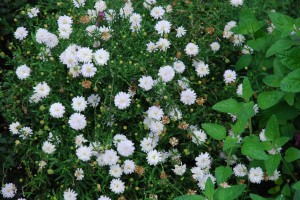Double Japanese asters (Kalimeris pinnatifida) are not true asters. They bloom in summer unlike the more popular fall blooming asters (Symphyotrichum spp.). Essentially, the genus Kalimeris (from Asia) and Boltonia (U.S. native) are closely related and used interchangeably.
‘Pinnatifida’ is without question the best known cultivar. In August the plant is smothered with 1-inch diameter semi-double white daisy flowers with buttery yellow centers. Blossoms mimic miniature mums. It forms an upright, bushy 2 to 3 feet tall plant. Small basal leaves form a rosette, each 2-3 inch long, narrow, and deeply cut lobes (pinnate); even smaller 1 inch long lance-shaped medium green leaves form around flowers.
Semi-double flowers do not reseed; over time a single plant will sucker and colonize around itself, and are not invasive. Kalimeris may be divide in spring to maintain overall vigor and to form new starts in your garden or friend’s. Fertilize in early sping with a slow release fertilizer such as Osmocote™, Nutrikote™ or Nature’s Source™. Foliage and flowers are not trouble by disease or pest issues.
Kalimeris is easily grown in moist, well-drained soil in full to partial sun (USDA hardiness zones 6-9). Mulching aids to reduce mid-summer drought stress and induce flower power. In hot southeast U.S. partial afternoon shade keeps plants blooming longer.
In shady spots plants may take on a wild rambling look; either cut-back them by half in early summer to develop a dense shrubby habit or remove surrounding vegetation. Utilize kalimeris for floral color in a perennial border, wild garden or meadow.
Japanese aster was a favorite of the late Elizabeth Lawrence, a wonderful southern garden writer.


 Posted in
Posted in 
